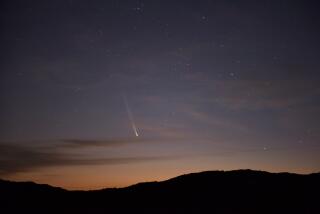Wave at Saturn: NASA’s Cassini spacecraft to take Earth’s picture
Earthlings, get ready to say cheese! NASA’s Cassini spacecraft will be taking your picture next month -- from 898 million miles away.
If you happen to have your eyes closed or your hair is out of place, don’t worry. All of planet Earth will fit into 1.5 pixels in the final image. Most of the frame will be filled by Saturn and its gigantic rings (though some of the edges will be cut off).
Scientists at the Jet Propulsion Laboratory in La Canada Flintridge are taking the picture – actually, a mosaic of images – because they can. It just so happens that Cassini and the sun will be on opposite sides of Saturn, allowing the spacecraft to see the planet and its famous rings with unusual clarity. Earth will make a cameo appearance to the right of Saturn’s south pole.
On JPL’s Wave at Saturn website, Cassini Project Scientist Linda Spilker explained what scientists hope to learn from the picture:
The main science goal for the mosaic we are making of the Saturn system is to look at the more diffuse rings that encircle Saturn and check for change over time. A previous mosaic of the Saturn system Cassini made in 2006 revealed that the dusty E ring, which is fed by the water-ice plume of the moon Enceladus, had unexpectedly large variations in brightness and color around its orbit. We’ll want to see how that looks seven Earth years and a Saturnian season later, giving us clues to the forces at work in the Saturn system. We’ll do this analysis by collecting data from our visual and infrared mapping spectrometer, composite infrared mapping spectrometer and ultraviolet imaging spectrograph in addition to the imaging cameras.
Not all of Earth will be visible in the picture, unfortunately. South America will be smack dab in the middle of the hemisphere that will be facing Cassini’s camera, surrounded by most of North America and parts of Antarctica and western Africa. Only North America will be illuminated at the time the photo will be taken, however.
You can check out a mock-up of how the picture will look at the Wave at Saturn website.
Saturn: Views of rings, moons and more
It will take about 15 mintes for Cassini to image the part of the sky that includes Earth, Spilker wrote. The photo session begins July 19 at 2:27 p.m. (Pacific).
For specific instructions on where to look in the sky, check out this blog post from Jane Houston Jones, a member of the Cassini education and public outreach team at JPL. For those in western states, Saturn (and Cassini) will be low on the eastern horizon at picture time. The site also has a guide for those in Chicago and New York.
This will be the third portrait of Earth taken from the outer solar system. The 2006 image Spilker described included a tiny dot of Earth from 926 million miles away. Despite that great distance, Cassini’s camera was able to catch a glimpse of the moon peeking out from behind Earth.
The first long-distance photo of Earth was snapped by Voyager 1 in 1990 from beyond the orbit of Neptune, about 4 billion miles away. Carl Sagan paid tribute to this photo in his book “Pale Blue Dot: A Vision of the Human Future in Space.” Here’s an excerpt of his description of that dot:
That’s us. On it everyone you love, everyone you know, everyone you ever heard of, every human being who ever was, lived out their lives. The aggregate of our joy and suffering, thousands of confident religions, ideologies, and economic doctrines, every hunter and forager, every hero and coward, every creator and destroyer of civilization, every king and peasant, every young couple in love, every mother and father, hopeful child, inventor and explorer, every teacher of morals, every corrupt politician, every “superstar,” every “supreme leader,” every saint and sinner in the history of our species lived there – on a mote of dust suspended in a sunbeam.
Thanks to the wonders of Youtube, you can hear Sagan pay tribute to this amazing picture.
Cassini was launched in 1997 and reached Saturn in 2004. It is equipped with 12 instruments that can detect magnetic fields, tiny dust particles and wavelengths of the light spectrum that are not visible to the human eye. The craft discovered a hurricane at Saturn’s south pole, large methane and ethane lakes on the moon Titan, and more than half a dozen other moons orbiting the ringed planet.
Return to Science Now.







